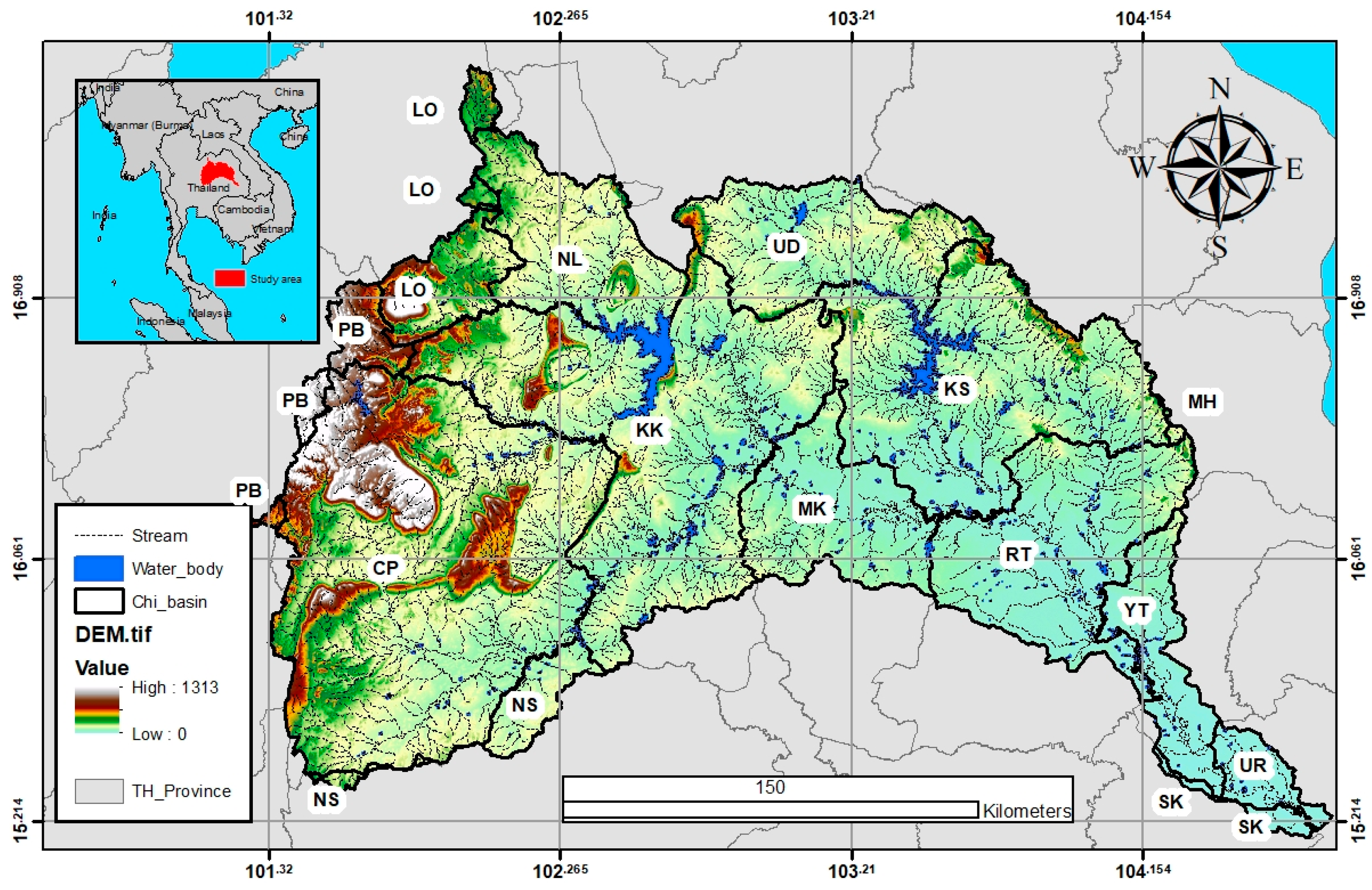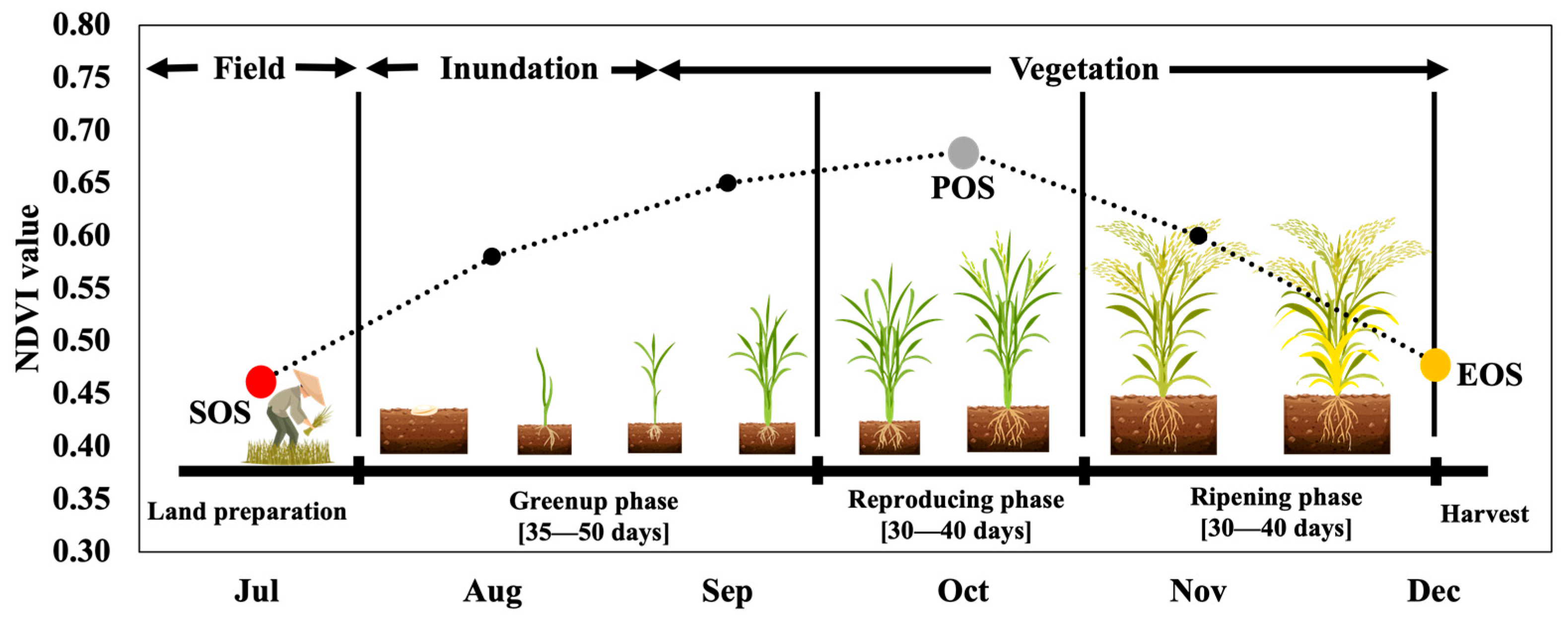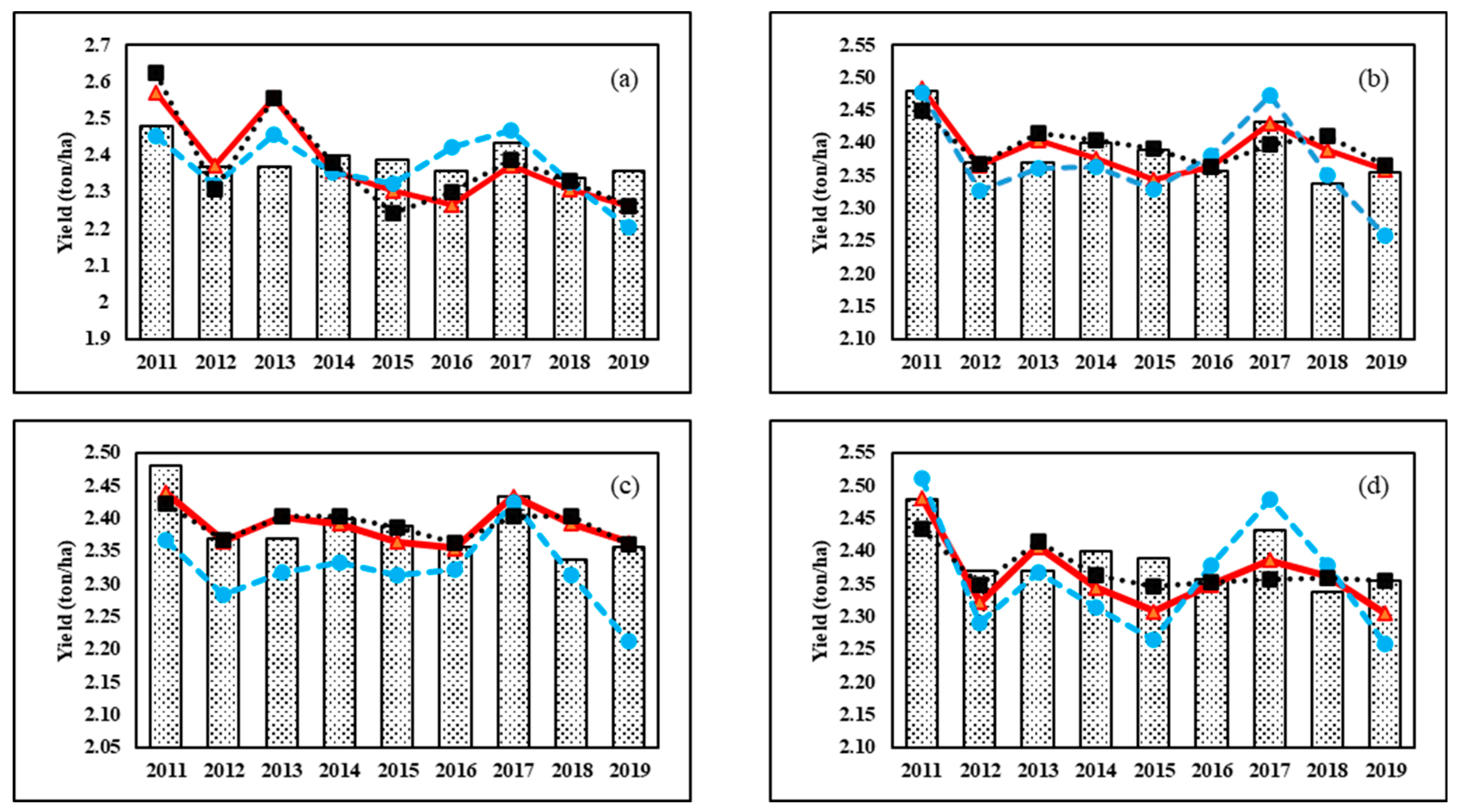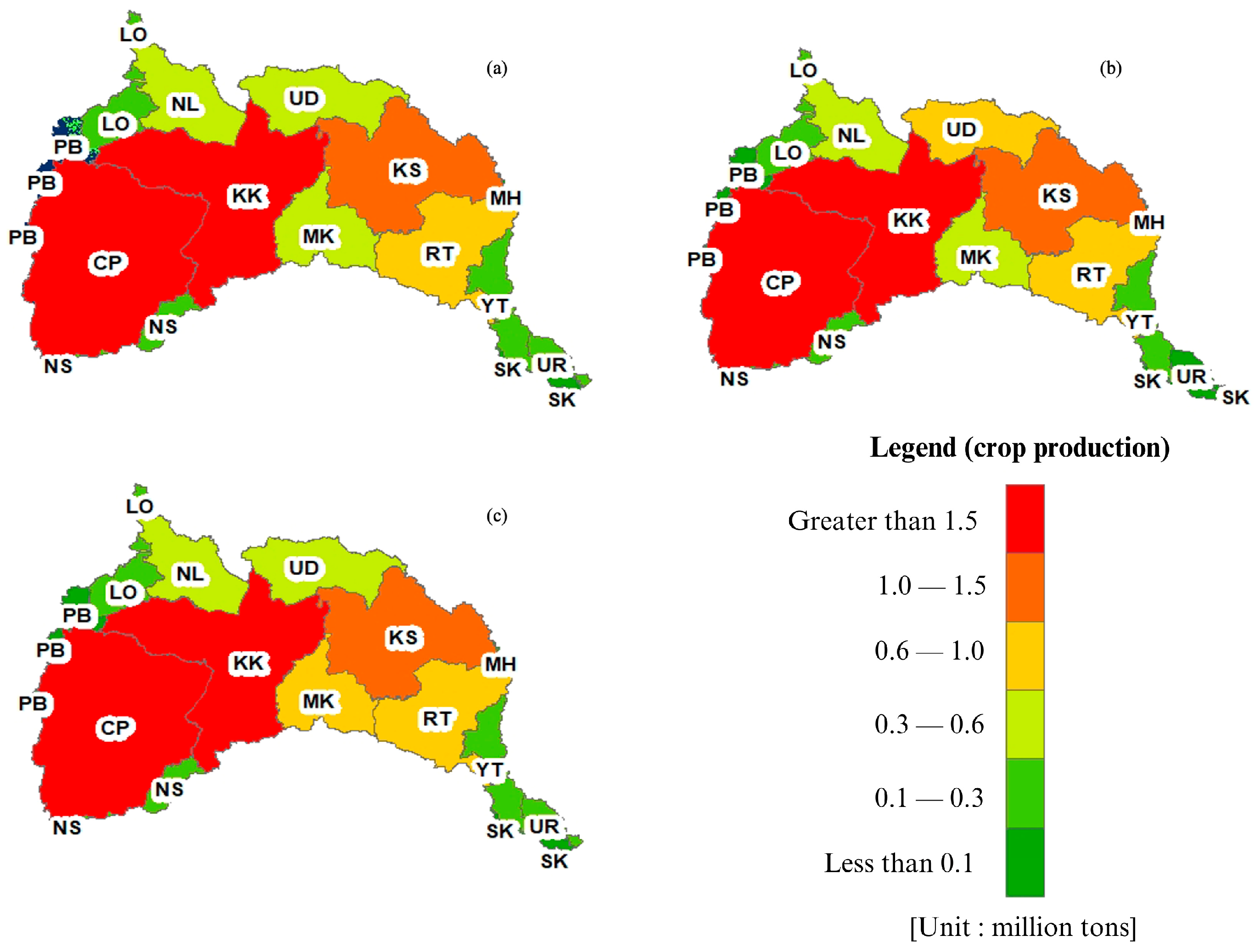Leveraging Remotely Sensed and Climatic Data for Improved Crop Yield Prediction in the Chi Basin, Thailand
Abstract
1. Introduction
2. Materials and Methods
2.1. Study Area
2.2. Crop Yield Data and Their Phenology
2.3. Remotely Sensed Data and Climate Data
2.4. Feature Selection: Correlation Analysis (CA) and Variance Inflation Factor
2.5. Regression Model
3. Results
3.1. Variables Selection
3.2. Regression Model Predictions for Province-Level Crop Yield Prediction in the Chi Basin
3.3. Temporal Trend of Crop Production Measurement and Changes of Crop Production Validation
3.4. Crop Yield Prediction between 2018 and 2022
4. Discussion
5. Conclusions
Author Contributions
Funding
Data Availability Statement
Conflicts of Interest
References
- Food and Agriculture Organization of the United Nations 2020 Asia Pacific Regional Overview of Food Security and Nutrition: Maternal and Child Diets at the Heart of Improving Nutrition. Available online: https://www.fao.org/documents/card/en/c/cb2895en (accessed on 1 August 2022).
- Department of Agricultural Extension Rice Production in Thailand. Available online: https://www.agriculture.gov.au/sites/default/files/documents/annual-report-2019-20-awe-oct-2020_0.pdf (accessed on 30 January 2024).
- World Bank Thai Economic Monitor Productivity for Prosperity. Available online: https://documents1.worldbank.org/curated/en/394501579357102381/pdf/Thailand-Economic-Monitor-Productivity-for-Prosperity.pdf (accessed on 30 January 2024).
- Intergovernmental Panel on Climate Change. Contribution of Working Groups I, II and III to the Fifth Assessment Report of the Intergovernmental Panel on Climate Change; IPCC: Geneva, Switzerland, 2014. [Google Scholar]
- Majumder, A.; Kingra, P.K.; Setia, R.; Singh, S.P.; Pateriya, B. Influence of Land Use/Land Cover Changes on Surface Temperature and Its Effect on Crop Yield in Different Agro-Climatic Regions of Indian Punjab. Geocarto Int. 2020, 35, 663–686. [Google Scholar] [CrossRef]
- Office of Agricultural Economics. Agricultural Statistics of Thailand 2016. Available online: https://www.oae.go.th/view/1/Home/EN-US (accessed on 14 December 2022).
- Land Development. Department Annual Report. Available online: https://webapp.ldd.go.th/lpd/pdfjs/web/viewer.html?File=../../node_modules/file/Report/Annual%20Report%202021.pdf (accessed on 30 January 2024).
- Han, J.; Zhang, Z.; Cao, J.; Luo, Y.; Zhang, L.; Li, Z.; Zhang, J. Prediction of Winter Wheat Yield Based on Multi-Source Data and Machine Learning in China. Remote Sens. 2020, 12, 236. [Google Scholar] [CrossRef]
- Gao, Y.; Wang, S.; Guan, K.; Wolanin, A.; You, L.; Ju, W.; Zhang, Y. The Ability of Sun-Induced Chlorophyll Fluorescence from OCO-2 and MODIS-EVI to Monitor Spatial Variations of Soybean and Maize Yields in the Midwestern USA. Remote Sens. 2020, 12, 1111. [Google Scholar] [CrossRef]
- Mkhabela, M.S.; Bullock, P.; Raj, S.; Wang, S.; Yang, Y. Crop Yield Forecasting on the Canadian Prairies Using MODIS NDVI Data. Agric. For. Meteorol. 2011, 151, 393. [Google Scholar] [CrossRef]
- Stepanov, A.; Dubrovin, K.; Sorokin, A.; Aseeva, T. Predicting Soybean Yield at the Regional Scale Using Remote Sensing and Climatic Data. Remote Sens. 2020, 12, 1936. [Google Scholar] [CrossRef]
- Mongkolnithithada, W.; Nontapun, J.; Kaewplang, S. Rice Yield Estimation Based on Machine Learning Approaches Using MODIS 250 m Data. Eng. Access 2023, 9, 75–79. [Google Scholar]
- Schwalbert, R.A.; Amado, T.; Corassa, G.; Pott, L.P.; Prasad, P.V.V.; Ciampitti, I.A. Satellite-Based Soybean Yield Forecast: Integrating Machine Learning and Weather Data for Improving Crop Yield Prediction in Southern Brazil. Agric. For. Meteorol. 2020, 284, 107886. [Google Scholar] [CrossRef]
- Pede, T.; Mountrakis, G.; Shaw, S.B. Improving Corn Yield Prediction across the US Corn Belt by Replacing Air Temperature with Daily MODIS Land Surface Temperature. Agric. For. Meteorol. 2019, 276–277, 107615. [Google Scholar] [CrossRef]
- Bouras, E.H.; Jarlan, L.; Er-Raki, S.; Balaghi, R.; Amazirh, A.; Richard, B.; Khabba, S. Cereal Yield Forecasting with Satellite Drought-Based Indices, Weather Data and Regional Climate Indices Using Machine Learning in Morocco. Remote Sens. 2021, 13, 3101. [Google Scholar] [CrossRef]
- Pei, F.; Wu, C.; Liu, X.; Li, X.; Yang, K.; Zhou, Y.; Wang, K.; Xu, L.; Xia, G. Monitoring the Vegetation Activity in China Using Vegetation Health Indices. Agric. For. Meteorol. 2018, 248, 215–227. [Google Scholar] [CrossRef]
- Bouras, E.H.; Jarlan, L.; Er-Raki, S.; Albergel, C.; Richard, B.; Balaghi, R.; Khabba, S. Linkages between Rainfed Cereal Production and Agricultural Drought through Remote Sensing Indices and a Land Data Assimilation System: A Case Study in Morocco. Remote Sens. 2020, 12, 4018. [Google Scholar] [CrossRef]
- Baniya, B.; Tang, Q.; Xu, X.; Haile, G.G.; Chhipi-Shrestha, G. Spatial and Temporal Variation of Drought Based on Satellite Derived Vegetation Condition Index in Nepal from 1982–2015. Sensors 2019, 19, 430. [Google Scholar] [CrossRef]
- Dutta, D.; Kundu, A.; Patel, N.R.; Saha, S.K.; Siddiqui, A.R. Assessment of Agricultural Drought in Rajasthan (India) Using Remote Sensing Derived Vegetation Condition Index (VCI) and Standardized Precipitation Index (SPI). Egypt. J. Remote Sens. Space Sci. 2015, 18, 53–63. [Google Scholar] [CrossRef]
- Herrero-Huerta, M.; Rodriguez-Gonzalvez, P.; Rainey, K.M. Yield Prediction by Machine Learning from UAS-Based Mulit-Sensor Data Fusion in Soybean. Plant Methods 2020, 16, 78. [Google Scholar] [CrossRef]
- Shahhosseini, M.; Hu, G.; Huber, I.; Archontoulis, S.V. Coupling Machine Learning and Crop Modeling Improves Crop Yield Prediction in the US Corn Belt. Sci. Rep. 2021, 11, 1606. [Google Scholar] [CrossRef]
- Khosla, E.; Dharavath, R.; Priya, R. Crop Yield Prediction Using Aggregated Rainfall-Based Modular Artificial Neural Networks and Support Vector Regression. Environ. Dev. Sustain. 2020, 22, 5687–5708. [Google Scholar] [CrossRef]
- Zhang, W.; Wu, C.; Li, Y.; Wang, L.; Samui, P. Assessment of Pile Drivability Using Random Forest Regression and Multivariate Adaptive Regression Splines. Georisk 2021, 15, 27–40. [Google Scholar] [CrossRef]
- Zhang, Y.; Xia, C.; Zhang, X.; Cheng, X.; Feng, G.; Wang, Y.; Gao, Q. Estimating the Maize Biomass by Crop Height and Narrowband Vegetation Indices Derived from UAV-Based Hyperspectral Images. Ecol. Indic. 2021, 129, 107985. [Google Scholar] [CrossRef]
- Kang, Y.; Ozdogan, M.; Zhu, X.; Ye, Z.; Hain, C.; Anderson, M. Comparative Assessment of Environmental Variables and Machine Learning Algorithms for Maize Yield Prediction in the US Midwest. Environ. Res. Lett. 2020, 15, 064005. [Google Scholar] [CrossRef]
- Memon, N.; Patel, S.B.; Patel, D.P. Comparative Analysis of Artificial Neural Network and XGBoost Algorithm for PolSAR Image Classification. In Lecture Notes in Computer Science (Including Subseries Lecture Notes in Artificial Intelligence and Lecture Notes in Bioinformatics), Proceedings of the 8th International Conference, PReMI 2019, Tezpur, India, 17–20 December 2019; Springer: Berlin/Heidelberg, Germany, 2019; Volume 11941 LNCS. [Google Scholar]
- Jeong, J.H.; Resop, J.P.; Mueller, N.D.; Fleisher, D.H.; Yun, K.; Butler, E.E.; Timlin, D.J.; Shim, K.M.; Gerber, J.S.; Reddy, V.R.; et al. Random Forests for Global and Regional Crop Yield Predictions. PLoS ONE 2016, 11, e0156571. [Google Scholar] [CrossRef]
- Pang, A.; Chang, M.W.L.; Chen, Y. Evaluation of Random Forests (RF) for Regional and Local-Scale Wheat Yield Prediction in Southeast Australia. Sensors 2022, 22, 717. [Google Scholar] [CrossRef]
- Boonwichai, S.; Shrestha, S.; Babel, M.S.; Weesakul, S.; Datta, A. Climate Change Impacts on Irrigation Water Requirement, Crop Water Productivity and Rice Yield in the Songkhram River Basin, Thailand. J. Clean. Prod. 2018, 198, 1157–1164. [Google Scholar] [CrossRef]
- Sujariya, S.; Jongrungklang, N.; Jongdee, B.; Inthavong, T.; Budhaboon, C.; Fukai, S. Rainfall Variability and Its Effects on Growing Period and Grain Yield for Rainfed Lowland Rice under Transplanting System in Northeast Thailand. Plant Prod. Sci. 2020, 23, 48–59. [Google Scholar] [CrossRef]
- Ramadhani, F.; Pullanagari, R.; Kereszturi, G.; Procter, J. Mapping a Cloud-Free Rice Growth Stages Using the Integration of Proba-v and Sentinel-1 and Its Temporal Correlation with Sub-District Statistics. Remote Sens. 2021, 13, 1498. [Google Scholar] [CrossRef]
- de Castro, A.; Six, J.; Plant, R.; Peña, J. Mapping Crop Calendar Events and Phenology-Related Metrics at the Parcel Level by Object-Based Image Analysis (OBIA) of MODIS-NDVI Time-Series: A Case Study in Central California. Remote Sens. 2018, 10, 1745. [Google Scholar] [CrossRef]
- Zhang, X.; Friedl, M.A.; Schaaf, C.B.; Strahler, A.H.; Hodges, J.C.F.; Gao, F.; Reed, B.C.; Huete, A. Monitoring Vegetation Phenology Using MODIS. Remote Sens. Environ. 2003, 84, 471–475. [Google Scholar] [CrossRef]
- Guo, Y.; Fu, Y.; Hao, F.; Zhang, X.; Wu, W.; Jin, X.; Robin Bryant, C.; Senthilnath, J. Integrated Phenology and Climate in Rice Yields Prediction Using Machine Learning Methods. Ecol. Indic. 2021, 120, 106935. [Google Scholar] [CrossRef]
- Peñuelas, J.; Filella, L. Technical Focus: Visible and near-Infrared Reflectance Techniques for Diagnosing Plant Physiological Status. Trends Plant Sci. 1998, 3, 151–156. [Google Scholar] [CrossRef]
- Mosleh, M.K.; Hassan, Q.K.; Chowdhury, E.H. Application of Remote Sensors in Mapping Rice Area and Forecasting Its Production: A Review. Sensors 2015, 15, 769–791. [Google Scholar] [CrossRef] [PubMed]
- Alahacoon, N.; Edirisinghe, M.; Ranagalage, M. Satellite-Based Meteorological and Agricultural Drought Monitoring for Agricultural Sustainability in Sri Lanka. Sustainability 2021, 13, 3427. [Google Scholar] [CrossRef]
- Zhang, L.; Jiao, W.; Zhang, H.; Huang, C.; Tong, Q. Studying Drought Phenomena in the Continental United States in 2011 and 2012 Using Various Drought Indices. Remote Sens. Environ. 2017, 190, 96–106. [Google Scholar] [CrossRef]
- Yu, H.; Li, L.; Liu, Y.; Li, J. Construction of Comprehensive Drought Monitoring Model in Jing-Jin-Ji Region Based on Multisource Remote Sensing Data. Water 2019, 11, 1077. [Google Scholar] [CrossRef]
- Tuvdendorj, B.; Wu, B.; Zeng, H.; Batdelger, G.; Nanzad, L. Determination of Appropriate Remote Sensing Indices for Spring Wheat Yield Estimation in Mongolia. Remote Sens. 2019, 11, 2568. [Google Scholar] [CrossRef]
- Uddin, M.P.; Al Mamun, M.; Hossain, M.A. PCA-Based Feature Reduction for Hyperspectral Remote Sensing Image Classification. IETE Tech. Rev. 2021, 38, 377–396. [Google Scholar] [CrossRef]
- Liao, K.; Xu, S.; Wu, J.; Zhu, Q. Spatial Estimation of Surface Soil Texture Using Remote Sensing Data. Soil Sci. Plant Nutr. 2013, 59, 488–500. [Google Scholar] [CrossRef]
- Boori, M.S.; Choudhary, K.; Paringer, R.; Kupriyanov, A. Spatiotemporal Ecological Vulnerability Analysis with Statistical Correlation Based on Satellite Remote Sensing in Samara, Russia. J. Environ. Manag. 2021, 285, 112138. [Google Scholar] [CrossRef] [PubMed]
- Guechi, I.; Gherraz, H.; Alkama, D. Correlation Analysis between Biophysical Indices and Land Surface Temperature Using Remote Sensing and GIS in Guelma City (Algeria). Bull. Soc. R. Sci. Liège 2021, 90, 158–180. [Google Scholar] [CrossRef]
- Kang, J.; Jin, R.; Li, X.; Zhang, Y.; Zhu, Z. Spatial Upscaling of Sparse Soil Moisture Observations Based on Ridge Regression. Remote Sens. 2018, 10, 192. [Google Scholar] [CrossRef]
- Hamzehpour, N.; Shafizadeh-Moghadam, H.; Valavi, R. Exploring the Driving Forces and Digital Mapping of Soil Organic Carbon Using Remote Sensing and Soil Texture. Catena 2019, 182, 104141. [Google Scholar] [CrossRef]
- Browning, M.H.E.M.; Kuo, M.; Sachdeva, S.; Lee, K.; Westphal, L. Greenness and School-Wide Test Scores Are Not Always Positively Associated—A Replication of “linking Student Performance in Massachusetts Elementary Schools with the ‘Greenness’ of School Surroundings Using Remote Sensing. Landsc. Urban Plan. 2018, 178, 69–72. [Google Scholar] [CrossRef]
- Alsharif, A.A.A.; Pradhan, B. Urban Sprawl Analysis of Tripoli Metropolitan City (Libya) Using Remote Sensing Data and Multivariate Logistic Regression Model. J. Indian Soc. Remote Sens. 2014, 42, 149–163. [Google Scholar] [CrossRef]
- Maya Gopal, P.S.; Bhargavi, R. Selection of Important Features for Optimizing Crop Yield Prediction. Int. J. Agric. Environ. Inf. Syst. 2019, 10, 54–71. [Google Scholar] [CrossRef]
- Rtayli, N.; Enneya, N. Enhanced Credit Card Fraud Detection Based on SVM-Recursive Feature Elimination and Hyper-Parameters Optimization. J. Inf. Secur. Appl. 2020, 55, 102596. [Google Scholar] [CrossRef]
- Dong, W.; Huang, Y.; Lehane, B.; Ma, G. XGBoost Algorithm-Based Prediction of Concrete Electrical Resistivity for Structural Health Monitoring. Autom. Constr. 2020, 114, 103155. [Google Scholar] [CrossRef]
- Genovese, C.R.; Roeder, K.; Wasserman, L. False Discovery Control with P-Value Weighting. Biometrika 2006, 93, 509–524. [Google Scholar] [CrossRef]
- Sakamoto, T.; Gitelson, A.A.; Arkebauer, T.J. Near Real-Time Prediction of U.S. Corn Yields Based on Time-Series MODIS Data. Remote Sens. Environ. 2014, 147, 219–231. [Google Scholar] [CrossRef]
- Zhuo, W.; Fang, S.; Gao, X.; Wang, L.; Wu, D.; Fu, S.; Wu, Q.; Huang, J. Crop Yield Prediction Using MODIS LAI, TIGGE Weather Forecasts and WOFOST Model: A Case Study for Winter Wheat in Hebei, China during 2009–2013. Int. J. Appl. Earth Obs. Geoinf. 2022, 106, 102668. [Google Scholar] [CrossRef]
- Ji, Z.; Pan, Y.; Zhu, X.; Wang, J.; Li, Q. Prediction of Crop Yield Using Phenological Information Extracted from Remote Sensing Vegetation Index. Sensors 2021, 21, 1406. [Google Scholar] [CrossRef]
- Ban, H.Y.; Ahn, J.B.; Lee, B.W. Assimilating MODIS Data-Derived Minimum Input Data Set and Water Stress Factors into CERES-Maize Model Improves Regional Corn Yield Predictions. PLoS ONE 2019, 14, e0211874. [Google Scholar] [CrossRef]
- Sun, J.; Di, L.; Sun, Z.; Shen, Y.; Lai, Z. County-Level Soybean Yield Prediction Using Deep CNN-LSTM Model. Sensors 2019, 19, 4363. [Google Scholar] [CrossRef]
- Lin, B.B. Agroforestry Management as an Adaptive Strategy against Potential Microclimate Extremes in Coffee Agriculture. Agric. For. Meteorol. 2007, 144, 85–94. [Google Scholar] [CrossRef]
- Ju, S.; Lim, H.; Ma, J.W.; Kim, S.; Lee, K.; Zhao, S.; Heo, J. Optimal County-Level Crop Yield Prediction Using MODIS-Based Variables and Weather Data: A Comparative Study on Machine Learning Models. Agric. For. Meteorol. 2021, 307, 108530. [Google Scholar] [CrossRef]
- Water Analysis and Assessment Division. Water Situation Report. Available online: http://mekhala.dwr.go.th/en/situation.php?numpage=value&Page=1875 (accessed on 30 January 2024).
- Raksapatcharawong, M.; Veerakachen, W.; Homma, K.; Maki, M.; Oki, K. Satellite-Based Drought Impact Assessment on Rice Yield in Thailand with SIMRIW-RS. Remote Sens. 2020, 12, 99. [Google Scholar] [CrossRef]
- Anderson, W.; Seager, R.; Baethgen, W.; Cane, M. Crop Production Variability in North and South America Forced by Life-Cycles of the El Niño Southern Oscillation. Agric. For. Meteorol. 2017, 239, 151–165. [Google Scholar] [CrossRef]
- Astuti, I.S.; Wiwoho, B.S.; Purwanto, P.; Wagistina, S.; Deffinika, I.; Sucahyo, H.R.; Herlambang, G.A.; Alfarizi, I.A.G. An Application of Improved MODIS-Based Potential Evapotranspiration Estimates in a Humid Tropic Brantas Watershed—Implications for Agricultural Water Management. ISPRS Int. J. Geoinf. 2022, 11, 182. [Google Scholar] [CrossRef]





| No. | Province | Acronym | 2011 | 2012 | 2013 | 2014 | 2015 | 2016 | 2017 | 2018 | 2019 |
|---|---|---|---|---|---|---|---|---|---|---|---|
| 1 | NAKHON RATCHASIMA | NS | 2.59 | 2.25 | 2.31 | 2.24 | 2.26 | 2.22 | 2.26 | 2.22 | 2.27 |
| 2 | SI SA KET | SK | 2.51 | 2.30 | 2.45 | 2.28 | 2.26 | 2.27 | 2.29 | 2.28 | 2.17 |
| 3 | UBON RATCHATHANI | UR | 2.16 | 2.15 | 2.15 | 2.06 | 2.06 | 2.09 | 2.18 | 2.27 | 2.25 |
| 4 | YASOTHON | YT | 2.54 | 2.27 | 2.28 | 2.31 | 2.21 | 2.23 | 2.22 | 2.27 | 2.25 |
| 5 | CHAIYAPHUM | CP | 2.46 | 2.36 | 2.39 | 2.21 | 2.19 | 2.25 | 2.32 | 2.29 | 2.32 |
| 6 | NONG BUA LAMPHU | NL | 2.41 | 2.33 | 1.97 | 2.01 | 1.98 | 2.11 | 2.16 | 2.07 | 2.08 |
| 7 | KHON KAEN | KK | 2.16 | 2.09 | 2.11 | 2.12 | 2.11 | 2.15 | 2.14 | 2.02 | 1.98 |
| 8 | UDON THANI | UD | 2.47 | 2.32 | 2.24 | 2.32 | 2.34 | 2.37 | 2.40 | 2.28 | 2.23 |
| 9 | LOEI | LO | 2.41 | 2.42 | 2.46 | 2.34 | 2.31 | 2.43 | 2.46 | 2.33 | 2.11 |
| 10 | MAHA SARAKHAM | MK | 2.37 | 2.32 | 2.33 | 2.30 | 2.28 | 2.30 | 2.23 | 2.18 | 2.25 |
| 11 | ROI ET | RT | 2.37 | 2.32 | 2.33 | 2.34 | 2.38 | 2.39 | 2.37 | 2.21 | 2.15 |
| 12 | KALASIN | KS | 2.32 | 2.26 | 2.26 | 2.29 | 2.30 | 2.32 | 2.30 | 2.31 | 2.33 |
| 13 | MUKDAHAN | MH | 2.40 | 2.24 | 2.26 | 2.40 | 2.40 | 2.40 | 2.38 | 2.47 | 2.19 |
| 14 | PHETCHABUN | PB | 3.54 | 3.54 | 3.61 | 4.37 | 4.36 | 3.46 | 4.33 | 3.53 | 4.40 |
| Data Type | Product | Variable | Spatial Resolution | Temporal Resolution | Acquisition Date | Data Source |
|---|---|---|---|---|---|---|
| Yield recorded | Crop yield | Provincial level | Annual | 2011–2019 | https://www.oae.go.th/ (accessed on 20 July 2022). | |
| RS data | MOD13Q1 | NDVI | 250 m | 16-day interval | 2011–2022 | https://lpdaac.usgs.gov/products/mod13q1v006/, (accessed on 20 July 2022). |
| EVI | 2011–2022 | |||||
| MOD11A2 | LST daytime | 1 km | 8-day interval | 2011–2022 | https://lpdaac.usgs.gov/products/mod11a1v006/. (accessed on 20 July 2022). | |
| LST nighttime | 2011–2022 | |||||
| Climatic data | ERA5 | Rainfall | 27.83 km | Monthly | 2011–2022 | https://www.ecmwf.int/en/forecasts/datasets/reanalysis-datasets/era5, (accessed on 20 July 2022). |
| Tmean | 2011–2022 | |||||
| Tmin | 2011–2022 | |||||
| Tmax | 2011–2022 |
| Data Type | Variable | p-Value | VIF |
|---|---|---|---|
| RS data | TCI | 0.001 ** | 1.31 |
| NDVI | 0.023 * | 1.22 | |
| LSTnighttime | 0.001 ** | 2.17 | |
| VCI | 0.001 ** | 15.49 | |
| VHI | 0.001 ** | 65.2 | |
| EVI | 0.035 * | 20.67 | |
| LSTdaytime | 0.37 | 11.19 | |
| Climate data | Tmean | 0.001 ** | 2.05 |
| Rainfall | 0.213 | 1.76 | |
| Tmax | 0.24 | 13.44 | |
| Tmin | 0.051 | 5 |
| Category | R-Square (Training: 2011–2017) | |||
|---|---|---|---|---|
| MLR | RF | XGBoost | SVR | |
| RS data | 0.42 | 0.74 | 0.89 | 0.64 |
| Climatic data | 0.55 | 0.94 | 0.93 | 0.88 |
| Combination | 0.63 | 0.92 | 0.95 | 0.81 |
| RMSE (Testing: 2018–2019) (ton/ha) | ||||
| RS data | 0.36 | 0.42 | 0.45 | 0.4 |
| Climatic data | 0.3 | 0.23 | 0.21 | 0.18 |
| Combination | 0.26 | 0.19 | 0.18 | 0.29 |
| Model | Year | Mean Actual Yield (ton/ha) | Variable | Change | ||||
|---|---|---|---|---|---|---|---|---|
| Combination | RS | Climate | ΔCombination | ΔRS | ΔClimate | |||
| Mean Predicted Yield (ton/ha) | Mean Predicted Yield (ton/ha) | Mean Predicted Yield (ton/ha) | ||||||
| Linear | 2018 | 2.34 | 2.37 | 2.35 | 2.34 | 0.03 | 0.01 | 0.01 |
| 2019 | 2.36 | 2.45 | 2.51 | 2.45 | 0.10 | 0.15 | 0.09 | |
| RF | 2018 | 2.34 | 2.28 | 2.32 | 2.26 | −0.05 | −0.01 | −0.07 |
| 2019 | 2.36 | 2.35 | 2.45 | 2.35 | 0.00 | 0.10 | −0.01 | |
| XGBoost | 2018 | 2.34 | 2.28 | 2.36 | 2.27 | −0.06 | 0.02 | −0.07 |
| 2019 | 2.36 | 2.35 | 2.50 | 2.35 | −0.01 | 0.14 | −0.01 | |
| SVR | 2018 | 2.34 | 2.31 | 2.30 | 2.31 | −0.02 | −0.04 | −0.02 |
| 2019 | 2.36 | 2.41 | 2.45 | 2.36 | 0.05 | 0.10 | 0.00 | |
| Area | Crop Yield Area (ha) | Crop Yield Ratio (ton/ha) | Total Crop Yield (Mton) | ||||||||
|---|---|---|---|---|---|---|---|---|---|---|---|
| Validation Period | Predicting Period | Validation Period | Predicting Period | ||||||||
| 2018 | 2019 | 2020 | 2021 | 2022 | 2018 | 2019 | 2020 | 2021 | 2022 | ||
| NS | 81,076 | 2.29 | 2.26 | 2.9 | 2.31 | 2.36 | 0.19 | 0.18 | 0.23 | 0.19 | 0.19 |
| SK | 16,562 | 2.29 | 2.29 | 2.36 | 2.26 | 2.45 | 0.04 | 0.04 | 0.04 | 0.04 | 0.04 |
| UR | 44,155 | 2.27 | 2.27 | 2.36 | 2.26 | 2.42 | 0.1 | 0.1 | 0.1 | 0.1 | 0.11 |
| YT | 125,803 | 2.29 | 2.26 | 2.36 | 2.38 | 2.36 | 0.29 | 0.28 | 0.3 | 0.3 | 0.3 |
| CP | 699,264 | 2.3 | 2.26 | 2.72 | 2.27 | 2.49 | 1.61 | 1.58 | 1.9 | 1.59 | 1.74 |
| NL | 216,043 | 2.23 | 2.23 | 2.27 | 2.66 | 2.2 | 0.48 | 0.48 | 0.49 | 0.57 | 0.48 |
| KK | 683,868 | 2.28 | 2.26 | 2.34 | 2.36 | 2.36 | 1.56 | 1.55 | 1.6 | 1.61 | 1.62 |
| UD | 256,024 | 2.29 | 2.26 | 2.3 | 2.36 | 2.32 | 0.59 | 0.58 | 0.59 | 0.6 | 0.59 |
| LO | 61,150 | 2.31 | 2.24 | 2.7 | 2.6 | 2.6 | 0.14 | 0.14 | 0.16 | 0.16 | 0.16 |
| MK | 247,999 | 2.28 | 2.28 | 2.32 | 2.32 | 2.45 | 0.56 | 0.56 | 0.58 | 0.57 | 0.61 |
| RT | 366,514 | 2.29 | 2.28 | 2.36 | 2.38 | 2.45 | 0.84 | 0.83 | 0.86 | 0.87 | 0.9 |
| KS | 418,757 | 2.29 | 2.28 | 2.32 | 2.36 | 2.26 | 0.96 | 0.95 | 0.97 | 0.99 | 0.95 |
| MH | 1254 | 2.32 | 2.26 | 2.36 | 2.66 | 2.33 | 0.01 | 0.01 | 0.01 | 0.01 | 0.01 |
| PB | 11,195 | 3.77 | 3.66 | 3.6 | 3.77 | 3.32 | 0.04 | 0.04 | 0.04 | 0.04 | 0.04 |
| Sum | 7.40 | 7.34 | 7.89 | 7.65 | 7.73 | ||||||
Disclaimer/Publisher’s Note: The statements, opinions and data contained in all publications are solely those of the individual author(s) and contributor(s) and not of MDPI and/or the editor(s). MDPI and/or the editor(s) disclaim responsibility for any injury to people or property resulting from any ideas, methods, instructions or products referred to in the content. |
© 2024 by the authors. Licensee MDPI, Basel, Switzerland. This article is an open access article distributed under the terms and conditions of the Creative Commons Attribution (CC BY) license (https://creativecommons.org/licenses/by/4.0/).
Share and Cite
Chaiyana, A.; Hanchoowong, R.; Srihanu, N.; Prasanchum, H.; Kangrang, A.; Hormwichian, R.; Kaewplang, S.; Koedsin, W.; Huete, A. Leveraging Remotely Sensed and Climatic Data for Improved Crop Yield Prediction in the Chi Basin, Thailand. Sustainability 2024, 16, 2260. https://doi.org/10.3390/su16062260
Chaiyana A, Hanchoowong R, Srihanu N, Prasanchum H, Kangrang A, Hormwichian R, Kaewplang S, Koedsin W, Huete A. Leveraging Remotely Sensed and Climatic Data for Improved Crop Yield Prediction in the Chi Basin, Thailand. Sustainability. 2024; 16(6):2260. https://doi.org/10.3390/su16062260
Chicago/Turabian StyleChaiyana, Akkarapon, Ratchawatch Hanchoowong, Neti Srihanu, Haris Prasanchum, Anongrit Kangrang, Rattana Hormwichian, Siwa Kaewplang, Werapong Koedsin, and Alfredo Huete. 2024. "Leveraging Remotely Sensed and Climatic Data for Improved Crop Yield Prediction in the Chi Basin, Thailand" Sustainability 16, no. 6: 2260. https://doi.org/10.3390/su16062260
APA StyleChaiyana, A., Hanchoowong, R., Srihanu, N., Prasanchum, H., Kangrang, A., Hormwichian, R., Kaewplang, S., Koedsin, W., & Huete, A. (2024). Leveraging Remotely Sensed and Climatic Data for Improved Crop Yield Prediction in the Chi Basin, Thailand. Sustainability, 16(6), 2260. https://doi.org/10.3390/su16062260









